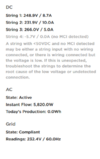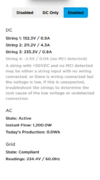Thanks Wayne, found out how to get some data.
Shut down Inverters one at a time to get readings. I started with Inverter 2 at 1:20pm today full sun, and then Inverter 1 at 1:30pm with full sun:
I do not have diagrams of string locations, but I am pretty sure they mentioned that Inverter 2 had south facing tiles when they were out here replacing MCI's.
At least 1 or 2 strings.
The info shown doesn't seem like much on Inverter 2, just as I suspected the problem is something there.
Prior to power cycling the inverters was the tesla app reading close to what the inverters showed (i.e. 6.62 kW total)? I ask because sometimes it can take the inverters a while after a reboot to find the maximum power point.
Without the plans it is really hard to say what is going on without a lot of guesses. You should have approximately 56 tiles on the North side, 31 tiles on the East, and 173 tiles on the South for a total of 258 tiles. Each tile's maximum operating point is 11V and 5.3A but due to temperature on the roof I would guess the actual voltage is a little less than 10.5V. We can use this value to determine the approximate number of tiles in each string. Any shading from roof vents, chimney, etc would affect these numbers. I couldn't make the numbers work unless I assume each inverter input contains two parallel strings. Given this I would guess the following:
Inverter 1
String 1: 2x24 tiles (North or South - about the right current for a North facing string this time of year)
String 2: 2x22 tiles (Likely South - producing full power)
String 3: 2x26 tiles (North or South - could be South with one of the parallel strings not operating)
Inverter 2
String 1: 2x15 tiles (East String - lowest number of tiles - not really putting out anything)
String 2: 2x20 tiles (North or South - seems like one of the parallel strings may not be operating)
String 3: 2x23 tiles (North or South - not really putting out anything)
I think this adds up to 260 total tiles, so the method is not exact but close. One assumption I am making here is that the parallel strings are on the same roof plane. If this is not the case it makes it even harder to make anything from the data.
The easiest string to identify is your East string since it is the shortest. These two strings in parallel are only putting out 0.5A which is nothing so either the inverter hasn't quite found the MPP after reboot or there is likely an issue here. The same with inverter 2 String 3.
Unfortunately it is harder to tell with the rest of the strings since they all have similar voltages and we are getting to the point in the year when there is not as much differentiation between North and South.
Inverter 1 String 3 and Inverter 2 String 2 seem to be putting out half the current they should be if they are really two strings in parallel.
Lots of guesses and assumptions here so I could be way off.




